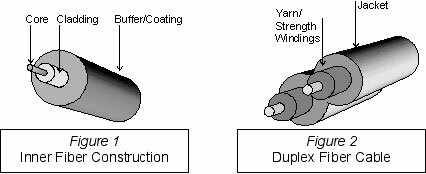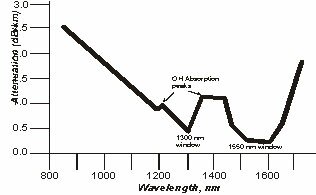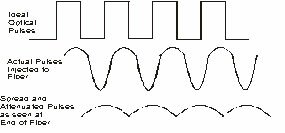UPDATED: Fiber Optics 101: A Primer
As a networking professional, sooner or later you'll need to understand the inner workings of fiber optic networking: What's the difference between singlemode and multimode, and how do they affect transmission speed? How can you get the longest distances? How can CWDM save you money? This article explains all of the above and more.
by Randy Bird
9/19/2001 -- (Updated 11/04): Fiber optic cabling has been used for long distance voice communications for more than 30 years, but voice was and is a slow-growth area. Over the last 10 years, however, the explosive increase in the Internet and other data communications applications has resulted in enormous requirements for bandwidth. As fiber is the technology best suited to providing this bandwidth, its use continues to spread out from the core backbones to enterprise networks and right on down to the desktop.
| -- advertisement (story continued below) -- |
|
|
While from a distance fiber optic communications may appear to be different from more familiar technologies, in reality the basics are pretty simple and easy to comprehend. This article is intended to shed some light on the principles and practices involved in fiber optics, so that you will have a working knowledge of what the elements of the systems are and how they work.
Why Fiber?
Fiber has a number of significant advantages, and a few disadvantages, relative to copper wire when used for communications:
- Fiber has vastly greater capacity for data transport. The bandwidth of a single strand of fiber is approaching 1 terabit (1,000,000,000,000) per second, and this will continue to increase for years as the technology improves. Within a building, installing fiber ensures compatibility with future data rates that likely will not be supported on today's Category 5 copper.
- The distance spanned on a single link is far greater. Distances of 100+ kilometers are achieved between electronic repeaters.
- Fiber does not emit electromagnetic noise. Suppressing electromagnetic interference from copper wiring is becoming a major technical challenge as the data rates increase. This also means that fiber is more secure, as stray signals cannot be picked up and decoded as can be done with copper-carried (or wireless) signals.
- Conversely, fiber is not susceptible to electromagnetic interference. As anyone who has run LAN wiring too close to heavy electrical equipment or fluorescent lights is aware, EMI can wreak havoc on data carried on unshielded wiring.
The only real advantage copper has had over fiber has been cost. As the number of fiber installations increases, and the technology to terminate the ends improves, the gap in cost between pulling fiber and copper cabling is getting fairly small. However, there is still a fairly wide difference in the cost of the electronics interfacing to the cabling, though again with volume this is coming down.
Fiber Construction
Fiber optic cabling consists of a carefully manufactured glass core inside of a cocoon of wrappers. Fibers are usually pulled in bundles of at least two strands, with large cables sometimes containing over 100 strands. Because the labor involved in pulling the fiber is much more costly than the material itself, it is common to pull extra capacity. Figure 1 shows the inner construction of a single fiber strand; Figure 2 shows a simple 2-fiber cable.

The core, where all the action takes place, is covered with a thin cladding designed to reflect and contain the light within the core itself. This in turn is surrounded by a buffer or coating for mechanical strength. Unjacketed fiber strands like this are used within equipment and patch panels, but they are too fragile to be out in the open and certainly couldn't be pulled. Two or more fiber strands are wrapped in yarn or some other type of material to provide tensile strength, then covered with a jacket to protect and hold the whole mess together. As with copper wiring, different materials with varying flammability and smoke ratings are required for plenum and non-plenum cabling. Fiber cabling is frequently routed within a conduit of some sort, either metal or plastic, providing an additional degree of protection.
Singlemode v. Multimode Fiber
There are two primary categories of fiber optic cabling, differentiated by the diameter of the core. Multimode fiber (Figure 3, below) has a core size of either 50 µm or 62.5 µm (100 µm exists but is uncommon except in Japan) surrounded by a 125 µm buffer. Singlemode fiber (Figure 4, below) has a much smaller core, 8-9 µm, and the same 125 µm buffer.

Figure 3: Multimode Fiber, Multiple Light Paths
With multimode fiber, light that is injected into the core can travel in many paths through the cable; think of it as rattling around inside a tube. Because these paths are each slightly different in length, the time to traverse a length of fiber can vary a little bit. This variance in time has the effect of spreading pulses of data out, which limits the bandwidth of multimode fiber – and the longer the run, the lower the bandwidth. Newer fibers can be made with a variable index of refraction in the glass of the core to reduce this effect, but in all cases multimode fiber is modal-bandwidth limited. Because of this, multimode fiber has been primarily used in LANs where the distance limitation has not been a problem.

Figure 4: Singlemode Fiber, One Light Path
Singlemode fiber, on the other hand, has such a narrow core that the light takes only one path through the glass. Hence, singlemode fiber is not limited by modal bandwidth and so supports vastly greater data rates than multimode fiber. Pulse spreading in singlemode fiber does still exist, due to the fact that different light wavelengths actually travel at slightly different speeds in the glass core, but this "chromatic dispersion" is inconsequential until you get into gigabit speeds. Even there, fibers have been developed that reduce or eliminate the problem, so that the singlemode fiber installed today can support data rates in the tens of gigabits per second over distances on the order of 100 km. All of the fiber installed in WANs and frequently in LANs spanning campuses of any size, is singlemode. The fiber itself is not much more expensive than multimode, though the small core size makes it more touchy to terminate correctly. There is, however, still a significant difference in the cost of the optoelectronics used with singlemode fiber compared to those used with multimode.
Fiber Optic Connectors
The ideal connector for fiber cabling is a fixed splice, where a precision machine operated by a skilled mechanic fuses two fibers permanently together with heat. Obviously, this technique lacks flexibility, and so various connectors have been developed to allow non-permanent connections. In all cases, the job of a fiber optic connector is to bring two minuscule glass cores in contact with one another with a great deal of precision. The tiny diameter of singlemode fiber, in particular, makes it imperative that the two cores align perfectly to ensure the light is contained. The SMA connector is a screw-on type, not widely used in new installations. The ST was designed by AT&T/Lucent; it is a "bayonet" push-and-turn connection. The SC connector is that specified by TIA 568A wiring standard; the action is push-pull. All of these connectors are available on prefabricated patch cords as well as in kits for field termination.

Figure 5: Standard Fiber Connectors
Recently, several new "small form factor" fiber optic connectors have entered the fray. Each of these takes up the same space as a twisted pair RJ-45, and is about half the size of the traditional connectors. The most common of these are the Volition VF-45, the MT-RJ and the LC, with the latter two fighting for the most market share over the last few years. In particular, the LC appears to be pulling ahead in the race, with the rapid increase in shipments of replaceable optoelectronic transceivers called “SFPs” (small form factor pluggable) with LC connections.

Figure 6: Small Form Factors (SFF) Connectors
Regardless of the connector used and the manufacturer's claims, connectors are always a trouble spot in fiber optic networks. Because of the small size of the mating fibers, the slightest contamination can result in blocking a fair amount of light and causing a bad, or even worse, intermittent connection. Fiber optic connectors should always be kept with the manufacturer's protective dust cap in place until the moment of mating, and excessive connection/reconnection discouraged. If dirty fiber is suspected, it should be cleaned with industrial-grade alcohol (drugstore-grade alcohol can leave a film when it evaporates) and a lint-free tissue. A good, clean fiber connection might have less than 0.5 dB of loss; a poor one, 2 dB or more. These losses are roughly equivalent to those seen in one to several miles of unspliced fiber optic cable, so you can see how important the connector quality is to the overall system.
See the Light
Just as copper cabling provides a medium for the transmission of information via electrons, the fiber optic cabling is just the conduit for the photons that actually do the work. Pulses of light at a particular wavelength (or color) are injected into the fiber by a transmitter and detected by a receiver. The physical characteristics of the glass fiber and the transmitter dictate the wavelength to be used. As shown on the diagram below, the fiber is most transparent (has the least loss) in bands around 1300 nm and 1550 NM

Figure 7: Fiber Loss Versus Wavelength
As inexpensive light emitting diode (LEDs) and Vertical Cavity Surface Emitting Laser (VCSEL) transmitters operate well at 850 nm, that wavelength is also used. These wavelengths are all out in the infrared range of the spectrum; you can see 850 nm as a dark red light, but 1310 nm and 1550 nm are invisible to the naked eye (the output power of these transmitters is limited to about 1 milliwatt in order to be categorized as Class I Eye Safe devices, but it is never a good idea to look into a transmitter.)
Transmitter Types
Several types of fiber optic transmitters have been designed to operate at one of these three wavelengths. The least expensive, LEDs, are used for multimode transmission at 850 nm or 1310 nm, but are limited in speed to 10 or 100 mbps Ethernet. Fabry-Perot (FP) laser diodes are relatively inexpensive and are typically used for singlemode transmission at 1310 nm Distributed Feedback (DFB) laser diodes are most expensive and are used for singlemode transmission at 1550 nm. The newer Vertical Cavity Surface Emitting Laser (VCSEL), is stadard for gigabit operation at 850 nm To give a rough view of the relative costs involved with these transmitters, the OEM cost in volume of a LED transmitter/receiver (transceiver) component is about $15; a FP laser transceiver, $60; a DFB laser, $300; and a gigabit VCSEL, $20. The receivers in these types of relatively inexpensive transceivers are pretty similar; they consist of a special diode (called a PIN, for positive-intrinsic-negative layers) that converts photons into electrons. Decent receivers are able to detect light levels down to the hundreds of nanowatts. Note that the receiver does not care if the transmitter is multimode or singlemode; it just knows that photons arrive, regardless of the path they take to get there.
Limiting Factors
In addition to the losses due to the length of the fiber attenuating the light, fiber optic communication systems have several other characteristics that act to put a limit on the distance a link can operate at. Multimode fibers have what is known as modal bandwidth, which in effect means that you have to trade off speed for distance. Singlemode fiber does not have this problem, but it does have what is called dispersion. Both of these effects tend to make the pulses of light smear as they travel down the fiber, to the point where one data bit cannot be distinguished from the next. In general, the more expensive the transmitter, the less subject its light pulses are to these effects, and hence the longer the distance that can be spanned on a given fiber.

Figure 8: Light Pulse Degradation
Roughly speaking, 850 nm and 1310 nm multimode systems can operate at distances from a few hundred meters to a couple of kilometers; see Table 1 below for examples. 1310 nm FP laser singlemode systems can range from 10 to 40 km; DFB lasers can reach up to 100 km with good fiber. If the distance spanned exceeds these limits, the light must be amplified directly (with a device known as an Erbium Doped Fiber Amplifier) or converted to electricity, regenerated, amplified, and converted back to light.
|
Minimum Distances over Multimode Fiber
|
| Application |
Wavelength |
Min. Distance |
| 10 mbps Ethernet, 10Base-FL |
850 nm MM |
2000 meters |
| 100 mbps Fast Ethernet, 100Base-FX |
1310 nm MM |
2000 meters |
| 100 mbps Fast Ethernet, 100Base-SX |
850 nm MM |
300 meters |
| Gigabit Ethernet, 1000Base-SX |
850 nm MM |
220 m / 550 m* |
| Gigabit Ethernet, 1000Base-LX |
1310 nm SM |
550 meters |
* 62.5µm / 50µm fiber
Wavelength Division Multiplexing
One of the areas of most development activity in the fiber optic arena today relies on the fact that multiple wavelengths (or colors) of light can use the same fiber at the same time. The most basic Coarse Wavelength Division Multiplexing (CWDM) can inexpensively double the capacity of a strand of fiber by injecting both 1310 nm and 1550 nm signals at the transmitter side, then separating the wavelengths out optically at the receiver. CWDM has also been standardized across 18 wavelengths spaced 20 nm apart from 1270 to 1610 nm. More powerful yet is Dense Wavelength Division Multiplexing (DWDM), where up to 100 wavelengths spaced about 0.4 nm apart from 1490 to 1611 nm can share the same fiber. With each of these wavelengths carrying a 2.5 or 10 gigabit per second signal (deployable with today's technology), a single fiber can carry more than a terabit of data per second!
The Future of Fiber
As demand for bandwidth continues to increase at an astronomical rate, fiber optic communication systems will become less exotic and more commonplace. Hopefully this article has dispelled some of the mystery surrounding the subject and left you with a basic understanding of this soon-to-be-everywhere technology. 
For more information on this topic, see Randy Bird's "Fiber Optics 102: Implementation Considerations" article, updated 11/04.
Questions or comments? Post them below!
Randy Bird is a consultant with 20 years of experience in networking hardware and software. He can be reached at .
More articles by Randy Bird:
|

